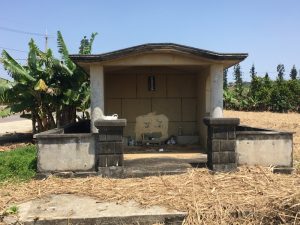
Incense lies on the beach after a ritual for Ryugu, the sea deity. Here nature is worshipped directly, without the need for shrines.
Last year I took the direct flight to the island of Miyakojima in Okinawa for a few days spring sunshine. It was so wonderful that I decided to go again, but this time instead of touring the island by rented car I decided to stay in a resort and enjoy the amenities. Since March is just before ‘the season’ starts, the small white sand beaches were mercifully empty. It meant I could inspect the surrounds at leisure.
In my previous posting on Miyakojima, I explored the distinctive religious heritage of the island. The two pillars of East Asian spirituality, animist and ancestral worship, were soon apparent even within five minutes walk from the resort. On the one hand were small shrines facing the sea where offerings were made to Ryugu, the ocean deity. On the other there were the characteristic tomb buildings in the nearby village where gatherings are held in honour of family ancestors.

A typical family tomb, set amidst a sugar cane field
This time I was able to spend time chatting to a local woman who was picking herbs amongst the coral-like rocks. She told me of how women gathered for rituals according to the old calendar, and how these were dying out as the new generation moves away and shows little interest.The Ryukyu language that she spoke at home was dying out too, and she recalled being punished for using it at school where standard Japanese was the only language allowed.
The villager told me too of the shamanic practices conducted at funerals, when the spirit of the dead person enters into the medium. She spoke of how one could easily tell if it was genuine or fake. As she described the event, I couldn’t help recalling very similar practices I’d witnessed in Korea. As there, the shamanic tradition in Miyakojima is very female-driven.
My last day on the island happened to be Doll’s Day by the old pre-Meiji calendar, and the custom is for the island women to purify themselves in the sea. With its pleasant blue water and pristine white sand, the beach spoke invitingly of immersion in nature. Here, you could sense, was a true communion of human and spirit world. But when the typhoons blow later in the summer, you can be sure the other aspect of the gods will be all too evident!
***********************
For the first of a series of four postings on Okinawan religion, please click here. For Okinawan ancestral worship, see here. For shrines and rituals, see here. For the wonderful chief Okinawan shrine, Seifa Utaki, please see here.
***********************

Purification in the sea is traditional on Dolls Day by the old calendar

A typical small worship place, with space for incense and offerings. It’s usual to leave behind the food and tin foil, cans and packets etc. In olden times these would have been bio-degradable.

Family tomb with open doors. Inside is a cavernous space in which urns are put. In previous times it would have been strewn with bones, in one composite ancestral mix.

An opened packet of salt is left as purification in front of a family tomb

Leave a Reply